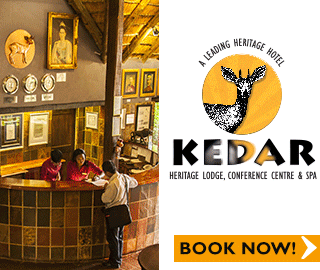

Africa's Top 10 Ecotourism Destinations
WORDS: KAJUJU MURORI | 26 FEB 2018 14:23
Eco-tourism has been taking shape in Africa with various individuals and organisations developing destinations that encompass pristine, fragile and relatively undisturbed natural areas for the benefit of the community and the traveller.
Africa has embraced eco-tourism, whereby tourism activities are aimed at not, but only bringing in revenue but also conservation of natural resources as well as a means to benefit the local communities in various capacities. And some spots in Africa have, which been created in an eco-friendly backdrop which is all about uniting conservation, communities and sustainable travel.
Everyone agrees it’s important to preserve Africa’s natural and cultural wonders for the future. But are you a green traveller? A responsible eco-tourist? A sustainable supporter? By being a conscientious traveller and staying in accommodations that put high value on preservation and minimising the negative impact on your surroundings, your stay can have a positive impact. To help you in this quest, we’ve listed a few places you can stay on safari that are eco-conscious.
.
Campi ya Kanzi, Kenya
Campi ya Kanzi was the first camp in Kenya to be gold rated by Ecotourism Kenya for its efforts in sustainable tourism.
One of the most environmentally friendly camps in East Africa, this lovely camp, whose name means "Camp of the Hidden Treasure" in Kiswahili, is in the Kuku Group Ranch, the natural corridor between Amboseli and Tsavo National Parks. It was the first camp in Kenya to be gold rated by Ecotourism Kenya for its efforts in sustainable tourism, and has won other prestigious international ecotourism awards. It's also co-owned by the Maasai from the ranch area Luca Belpietro and his wife, Antonella Bonomi. The ranch itself stretches 1,115 square km (400 square miles) from the foothills of Mt. Kilimanjaro to the Chyulu Hills in the east, and because of the different altitudes, you’ll find all sorts of habitats, from wide plains and riverine bush to high mountain forests. You'll also find plenty of game—more than 60 mammals and 400 bird species—but few tourists. To see all this, choose between game drives (where the game is really wild and not used to vehicles), guided game walks, botanical walk, bird-watching, and cultural visits.
Take your kids to the Maasai school and open their eyes to a completely different way of life. The main lounge and dining areas are in Tembo (Elephant) House, which has superb views of Mt. Kilimanjaro, the Taita Hills and Chyulu Hills. All the tents have great views, as well as wooden floors, a veranda, and an en suite bathroom with bidet, flush toilet and hot and cold running water. The Hemingway and Simba tented suites boast king-size beds, a dressing room, en suite bathroom with his-and-her washbasins, and verandas overlooking Mt. Kilimanjaro. Note that there is an additional US$100 per-person, per-day conservation fee, which entirely benefits the local Maasai community.
Sindabezi Island, Zambia
Sindabezi Island is the Zambezi’s most environmentally friendly property. The island makes use of recycled wood chips and solar power for heating, all the gray water is recycled, and the chalets are constructed mainly from sustainable forests. There’s a strict 10-guest limit and each of the island’s chalets is raised on a wooden deck built artistically around the existing trees. There is absolutely no electricity on the island, and hot water is provided on demand. If your party books Sindabezi exclusively, the guide, boat and land vehicle are at your disposal. Dinner is served by lantern and candlelight on a sandbank or wooden deck under the stars.
Porini Rhino Camp, Kenya
Porini Rhino Camp is the largest black rhino sanctuary in East Africa. The camp has no permanent structures and is strategically constructed around trees and shrubs to minimise the human footprint on the natural landscape. The camp uses solar power for electricity, and water is heated with eco-friendly, sustainable charcoal briquettes; there is no generator. The conservancy is owned by the local Masai, and the camp is run with the aim of creating income for the tribe.
This delightful eco-friendly tented camp is nestled among Kenya's ubiquitous Acacia tortilis trees in a secluded valley in the Ol Pejeta Conservancy. This 90,000-acre stretch of game-rich wilderness lies between the snow-capped Mt. Kenya and the foothills of the Aberdares. This location treats guests to a double whammy—abundant game including the Big Five, wild dog and the endangered black rhino and superb views across the open plains. Each beautifully placed tent has stunning views from its personal veranda, and inside there's an en-suite bathroom with flush toilet and bucket shower with hot water heated by solar power. Sip sundowners from a carefully chosen vantage point, and then take a spectacular night drive. By day, stretch your legs on a guided bush walk with a Maasai guide or have your heartstrings tugged at the nearby Sweetwaters Chimpanzee Sanctuary.
If you're feeling extra energetic and really want to walk on the wild side, then the camp also offers walking safaris. The all-inclusive price includes round-trip transfers by air from Nairobi, Ol Pejeta conservancy fees, all game drives, sundowners, walks with Maasai warriors, full board and free house wines, beer, and soft drinks. Porini Rhino Camp is located in the largest black rhino sanctuary in East Africa. The camp has no permanent structures and is strategically constructed around trees and shrubs to minimise the human footprint on the natural landscape. The camp uses solar power for electricity, and water is heated with eco-friendly, sustainable charcoal briquettes; there is no generator. The camp has a silver eco-rating for its low eco-footprint.
Ngwesi Camp, Kenya
Ngwesi Camp is a shining example of how a safari lodge can reduce poverty and strengthen partnerships between the tourist trade and local communities in Africa. Built only with local materials, the camp is completely solar powered, and its water comes from a nearby spring and is gravity fed to the lodge. The local Masai community helped build and continues to run the camp through a communal group.
Situated on a rocky outcrop in the north of the Lewa Wildlife Conservancy, this intimate and environmental award-winning lodge prides itself on its successful efforts to integrate community development and sustainable environmental management. The comfortably furnished open-walled bandas with open-air showers are made of local materials and built on a slope—their fronts rest on wooden stilts—thus giving uninterrupted views of the surrounding wilderness. Make sure you take the opportunity to sit out at the main lodge and watch the water hole below or cool off in the horizon pool, which gently flows down into the bush below; water is gravity-piped from a nearby natural spring. You'll see plenty of game including lion, leopard, cheetah, hyena, the elusive wild dog and large herds of elephants and buffalo, plus the plains game. Learn about hunting, gathering honey, animal trapping with indigenous poisons, or fashioning beadwork with the local Maasai at the nearby Masai Cultural Manyatta.
Damaraland Camp, Namibia
Set on Namibia’s Skeleton Coast between Khorixas and Torra Bay, this beautiful 10-tent camp manages to integrate conservation and community development with the tourist mission of the camp. With the assistance of the Integrated Rural Development & Nature Conservation (IRDNC), the World Wildlife Fund (WWF), and other sustainable development organisations, Wilderness Damaraland Camp has included local indigenous tribes in the protection and management of wildlife and the land surrounding the camp, giving them an income, training and the feeling of ownership in the community. Elephant, black rhinoceros, oryx, kudu, springbok are just a few species that might be spotted at Damaraland Camp. There are also opportunities to visit the nearby Twyfelfontein engravings, one of the most unique rock art sites in Southern Africa, which provide evidence of human habitation of life at Twyfelfontein more than 6,000 years ago.
Grootbos Private Nature Reserve, South Africa
Only two hours from Cape Town, Grootbos Private Nature Reserve is home to the largest private fynbos garden in the world. Set on 2,500 acres of Western Cape landscape overlooking Walker Bay, Grootbos offers up-close observation of Protea, fynbos, milkwood forests and tropical rain forests as well as aquatic life including penguins, dolphins, seals and Southern Right Whales in early spring. Luxury accommodations include private cottages with fireplaces and sundecks, and exquisite cuisine is enhanced by vegetables and herbs grown on the premises. The reserve’s foundation works to educate and employ the community with a variety of conservation, research and sustainable living projects.

Islands of Siankaba, Zambia
Islands of Siankaba is about 48 km (30 mi) upstream from Victoria Falls. Awarded the Environmental Certificate by the Environmental Council of Zambia in 2002, shortly before its opening, the lodge is on two forested islands in the Zambezi River. A suspension bridge links the two islands and leads to an overhead walkway in the tree canopy that connects the elevated chalets to the lodge’s restaurant. The walkways protect the islands’ delicate riverine environment. The lodge was constructed with mostly commercially grown, non-indigenous pine. Where local wood was used, the lodge planted hardwood saplings to replace them. Electricity is drawn from the Victoria Falls hydroelectric plant, and river water is recycled and treated on-site for use in the camp. Local tribes are employed by the lodge, where sunset cruises, mokoro rides, guided nature walks, white-water rafting and bungee jumping are all on the menu.
Chumbe Island, Tanzania
Chumbe Island, between the Tanzanian coast and the islands of Zanzibar, is the country’s first marine national park. It is home to 400 species of coral, 200 species of fish and a boutique luxury hotel. The island’s ecotourism concept was the brainstorm of a German conservationist who, since the early 1990s, has succeeded in developing it as one of the world’s foremost marine sanctuaries. Seven thatch bungalows with specially built roofs catch rainwater that is funneled into bathrooms through a tank in the floor. Electricity is solar powered, and toilets are doused in sweet-smelling compost and later cleaned. Scuba diving, snorkeling, island hikes guided by expert rangers and outrigger boat rides leave you with plenty to do while you absorb the lesson of sustainability at Chumbe.
Chief’s Camp, Botswana
Chief’s Camp is in the exclusive Mombo Concession of the Okavango Delta’s Moremi Game Reserve. The area is home to the rare white rhino and is the only area in Botswana, where these animals can be seen in their natural environment. Also, the limited number of suites is part of the camp’s commitment to low-impact tourism. The camp works in partnership with the non-profit Friends of Conservation in an effort to involve the local community in the running of the camp.
Hog Hollow, South Africa
Just outside Plettenberg Bay, Hog Hollow Country Lodge is a beautiful oasis run by Andy Fermor and Debbie Reyneke, a conscientious couple dedicated to employing local people. The lodge, in a private reserve, has views of the surrounding valleys and Tsitsikamma Mountains. Personalised service is one of the hallmarks of a stay at Hog Hollow. The main lodge and 12 cottages straddle a central dam, creating a serene hideaway that blends with the landscape and indigenous forest. The house includes a pool overlooking the Matjes River gorge, and one of the outdoor lounges has a grand old fig tree sprouting up through its wooden deck, providing an excellent perch for bird-watchers. Hike through the surrounding forest or take a quick drive to Keurbooms Beach and Nature’s Valley, both just 10 minutes from Hog Hollow.
















